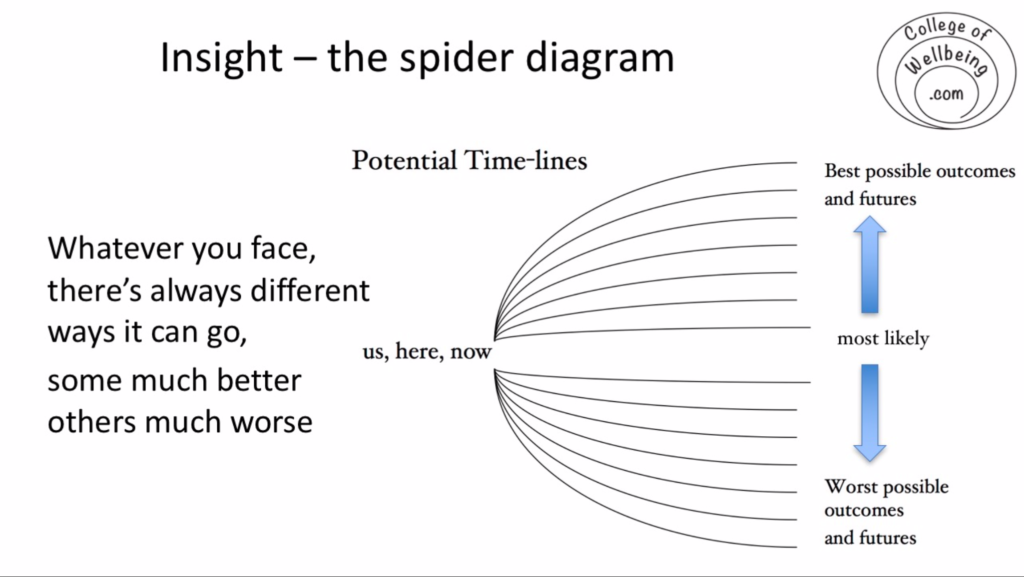Resilience is the skillset of our time. And in today’s fast-paced world, the need for upskilling with resilience training is paramount. How can we transform from a state of collapse to a state of presence and flexibility?
This video shares a discussion with Dr. Chris Johnstone (above) about Seven Ways To Build Resilience and the role of resilience in nurturing wellbeing.
This is a recording of a webinar that forms part of a free ‘Building Wellbeing Together’ webinar series from the Network of Wellbeing (NOW).
Our discussion starts at about 3:43: if you’re short of time and would like to watch the highlights please scan down to find these listed.
Highlights:
At 5:52: We can think about three levels of resilience – me, you and us.
- Me is about self-care and self-help
- You is about supporting resilience in others
- Us is about collective resilience: whatever larger system we’re a part of (family, team, organisation, community, ecosystem, etc.)
At 8:40: We’re increasingly hearing about the important of resilience skills. These are relevant not just within the context of challenges such as climate change, but also to people feeling overwhelmed at work, in their personal lives, and with the increasing prevalence of burnout. But what is resilience?
Resilience is a set of qualities, strengths and processes that helps us deal with difficult times.
At 13:40: Resilience is a two-part story:
- Here’s me facing this difficulty (the starting point or downslope of difficulty).
- And then there’s what happens next (the upslope of response).
Resilience is about what helps…
At 14:08: Whatever we’re facing, there are things that can help us rise to the occasion and find our strengths. Learnable resilience skills include problem solving, drawing in support, and dealing with our own emotional reactions.
Looking at the things that help us move from feeling in a state of collapse to being in a state of presence. Finding our best self and our best response.
At 16:13: Resilience helps us future-proof. We know that it’s reasonably foreseeable that something will go wrong in life, and there will be bumpy times ahead. Whilst we don’t control life, we can influence it by recognising what’s in the way, and thinking realistically.
At 17:50: Positive wellbeing is a direction you can move in from any starting point. Wherever you are, and whatever you face, there are always different ways life can go – some much better, others much worse. These can be represented in a spider diagram.

Our commitment to ourselves is to find the best leg of the spider! Resilience comes in when we find ourselves on one of the more difficult legs of the spider. It’s what helps us when things take a turn for the worse.
At 21:30: Frustration tolerance is a great resilience strength. It’s about hanging on in there even when things aren’t going well. “I’m struggling, I can’t see a way, but if I just carry on, what will help? I’m going to trust that I will find a way”.
At 23:00: What does a story of resilience look like when I find myself on a difficult leg of the spider? When things take a turn for the worse, how can we make a better outcome more likely? How can we apply strategies and insights that aim towards wellbeing from whatever starting place? How can we turn a minus into a plus?
Ask yourself three questions:
- What’s the best that can happen?
- What’s the worst that can happen?
- What’s most likely to happen?
How can we make the best most likely, and the worst less likely? This is Active Hope.
At 25:00: Storyboarding Exercise
A storyboard is a way of thinking about the different elements in a story. To act more from a place of resilience, it helps us to think about the different elements in a story of resilience and what our choice points are.
Build yourself a six-part storyboard by sitting with and answering the following questions:
Starting point. Here’s me facing the challenge of…
Hoped for outcome. What I’d like to happen here…
In the way of this. Obstacles or difficulties include…
Facing all that, what helps me is…
Turning or shift that might happen if I were to…
Steps (specific and achievable) I can take in the next seven days to move forward are…

At 46.25: Wellbeing and resilience are bound up together. Wellbeing is a direction to move in from any starting point.
It’s about moving in the direction of “What does it look like when things work out well?”
Resilience is what helps us do that in difficult conditions when things challenge or threaten our wellbeing. Resilience lives in the context of adversity.
At 49:14: Self-compassion and growth mindset are resilience responses. Resilience can often be seen as being about trying harder. But sometimes it’s about easing off, giving ourselves a break, taking a pause for renewal and holding open the possibility that you will find a way.
Resilience is about being skilful in our choice of tool. it’s about recognising when to lean into frustration tolerance and when to ease off.
Useful Links and References:
You can buy Chris’ latest book and new online course Seven Ways to Build Resilience
Explore Chris’ wider resilience work at collegeofwellbeing.com
